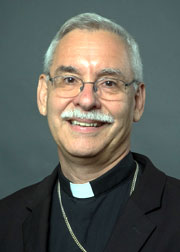Official Website of the
Catholic Diocese of Little Rock
Arkansas Catholic Charismatic Conference 2021
Published: July 23, 2021
Bishop Anthony B. Taylor preached the following homily on the feast of St. Bridget of Sweden during the opening Mass of the Arkansas Catholic Charismatic Conference at the Wyndham Riverfront Hotel in North Little Rock on Friday, July 23, 2021.

Bishop Taylor
Two thousand years ago, when God poured out the Holy Spirit on that first Pentecost, it was to empower the disciples and equip the Church with all the gifts they needed to proclaim the Gospel in such a way as to convert the hearts of those who heard the Good News.
These gifts were abundant, including the seven traditional gifts of power and light we receive in confirmation:
- power —experienced as fortitude, piety and fear of the Lord; and
- light — experienced as wisdom, understanding, counsel and knowledge.
If embraced, these seven gifts of the Spirit lead to the nine fruits of the Spirit mentioned by St. Paul in his letter to the Galatians. These nine fruits of the Spirit are the attributes of persons and communities that live in accord with the Holy Spirit, namely: love, joy, peace, patience, kindness, goodness, faithfulness, gentleness and self-control.
St. Bridget of Sweden was one of the great mystics of the Middle Ages, such a great figure in her time that in 1999 St. John Paul II named her one of the patron saints of Europe. And yet how many of you know anything much about her? You know, a “mystic” is one of the things that they called charismatics in the Middle Ages.
Having given birth to the Church that first Pentecost, the Holy Spirit has continued to accompany the Church through all the ups and downs of history, inspiring people to holiness and providing the Church with the spiritual resources needed to address the changing challenges of each succeeding age.
By the way, did you ever wonder why the Vatican flag is white and yellow? It is to remind us that we are to be the salt of the earth — the white, and the light of the world — the yellow. That applies to all Christians, but especially those of us who have been baptized in the Spirit.
Today we celebrate the 50th anniversary of the Catholic Charismatic Renewal in Arkansas, but when I began to prepare this homily for the opening Mass of this year’s convention, I noticed something special about this particular day, July 23, which is the feast of St. Bridget of Sweden.
She was one of the great mystics of the Middle Ages, such a great figure in her time that in 1999 St. John Paul II named her one of the patron saints of Europe. And yet how many of you know anything much about her? You know, a “mystic” is one of the things that they called charismatics in the Middle Ages.
My first exposure to St. Bridget was through the religious order she founded, the Order of the Most Holy Savior, now called the Bridgettines. Italians call them the "Suore Svedesi," literally “the Swedish sisters” even though today many of them actually come from India. Once I stayed with the Bridgettines a few days in the house they have for pilgrims at Assisi. These sisters wear a distinctive head-dress with five red dots representing the five wounds of Christ. In any event, let me tell you a little bit about her.
St. Bridget lived in the 1300s and was from a prosperous family, the daughter of the governor of the region that included Stockholm, the capital. Even as a child, she was uniquely open to the movement of the Holy Spirit and from an early age she had remarkable religious visions that influenced her entire life and outlook.
At age 13 she was married and eventually had 8 children — which also influenced her outlook. Once the children were raised and her husband had died, she retired to a life of penance and prayer in a monastery. She went to Rome in 1350 at the time of the Black Death and spent the rest of her life there, exercising a wide, spirit-filled apostolate among the rich and poor, sheltering the homeless and sinners, and working for the return of the papacy from Avignon to Rome. She died 648 years ago today, July 23, 1373.
Today’s charismatics have an especially strong relationship with Holy Spirit, the third person of the Blessed Trinity, and are open to receiving messages from God that speak to our present circumstances. We often experience jubilation in prayer. Typical of medieval piety, St. Bridget’s mystical experiences derived from the Holy Spirit but focused more on Jesus, the second person of the Blessed Trinity, and in her case, particularly on his suffering.
This spoke especially to the lived experience of people who had survived the Black Death. At the age of 10 St. Bridget had a mystical experience that set the direction for the rest of her life. She had a vision of Jesus hanging on the cross and he seemed to say “Look upon me, my daughter,” and when she had done so, she asked who had done this, Jesus answered: “They who despise me and spurn my love for them.”— and isn’t it true that many people spurn God’s love for them even today?
At a later point, when meditating on the passion of Christ, Jesus gave her further instruction in prayer, out of which developed the Holy Wounds of Jesus devotion, which was very popular throughout the Middle Ages. Our times are different, so God reaches out to us in ways that correspond to our situation.
For instance, we are in the midst of a time of pandemic. So far it has not been nearly as deadly as the Black Death of St. Bridget’s time, which killed 25 percent of the population of Europe, but today’s coronavirus has given us a glimpse of what that suffering might have entailed, even though the Black Death was thousands of times worse — the fear, the isolation, the feeling of powerlessness. And they had no hope of a vaccine — such things didn’t exist in the Middle Ages.
But maybe in this time of our own crisis, we also can hear the Lord speaking to us from the cross, saying to us “Look on me, my son/daughter." Even if you have been spared, consider my people in India and throughout the third world who have very little access to the vaccine and are dying by the thousands daily.
Can we not see in them the suffering of Jesus dying on the cross? And for that matter, even here we have many people who out of fear or ignorance or stubbornness have not gotten vaccinated when they could and are now suffering the consequences. My heart goes out especially to those who now experience great remorse because they underestimated the danger and have now infected loved ones who are vulnerable and struggling. The same was true with the Black Death 650 years ago.
From St. Bridget we learn that the Holy Spirit is not just here in the happy times. He is here all the time, in joyful moments and in sad moments and in moments of remorse, uniting us to Jesus in the suffering of his cross so that we may also share in the joy of the kingdom of God, starting with the birth of the Church that first Pentecost 2,000 years ago.









